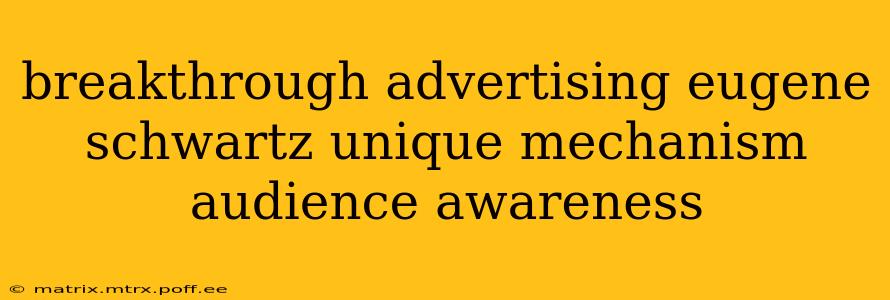Eugene M. Schwartz, a legendary copywriter, revolutionized advertising with his unique approach focused on understanding and targeting specific audience segments. His strategies, detailed in his seminal work "Breakthrough Advertising," move beyond generic appeals, instead pinpointing the precise needs and desires of a finely-tuned audience. This approach, while decades old, remains incredibly relevant in today's fragmented digital marketing landscape. Schwartz's methods offer a potent combination of psychological insight and strategic marketing that can significantly improve advertising effectiveness. This article will delve into the core principles of Schwartz's methodology, exploring how he achieved breakthrough results and how his techniques can be applied to modern marketing.
What is the Unique Mechanism in Breakthrough Advertising?
Schwartz's "unique mechanism" isn't a single tactic, but a systematic approach to advertising. It centers on identifying and precisely targeting specific stages of audience awareness. He argued that generic advertising fails because it attempts to speak to everyone, effectively speaking to no one. Instead, he proposed a tiered system, understanding that different audiences require different messaging and approaches. This involves identifying the specific problems and desires of your target audience at their particular stage of awareness.
What are the Stages of Audience Awareness According to Eugene Schwartz?
Schwartz outlined several stages of audience awareness, each requiring a different advertising strategy:
- Stage 1: Unaware: This audience isn't even aware they have a problem. Your advertising here needs to create awareness and introduce the problem itself, subtly hinting at a solution. This is the most challenging stage.
- Stage 2: Problem Aware: The audience is aware of the problem but hasn't considered a solution. Your ads focus on validating their problem and gently introducing your product as a possible solution.
- Stage 3: Solution Aware: The audience knows the problem and is aware of potential solutions, but may not be aware of your specific product. Your ads should position your product as the superior solution, emphasizing its unique benefits.
- Stage 4: Product Aware: The audience is aware of your product but hasn't yet decided to buy. This stage requires persuasive messaging emphasizing the value proposition and overcoming objections.
- Stage 5: Most Aware: This audience is ready to buy and only needs a final nudge. Your advertising here can be more direct and focused on the call to action.
How Does Eugene Schwartz's Method Differ from Traditional Advertising?
Traditional advertising often relies on broad, general appeals hoping to resonate with a large audience. Schwartz’s method is more precise, targeting specific segments based on their level of awareness. This means crafting tailored messages that speak directly to their needs and concerns at each stage. Instead of shouting to the masses, he advocates for whispering the right message to the right ear at the right time. This targeted approach results in greater conversion rates and a higher return on investment.
What are some Examples of Breakthrough Advertising?
While Schwartz himself didn't leave behind many specific examples meticulously labeled as "breakthrough advertising," the principles he espoused can be seen in numerous highly successful campaigns throughout history. Think of iconic ads that resonated deeply with a specific audience—they often implicitly (or explicitly) understood and addressed the audience's unique stage of awareness. Analyzing successful campaigns through this lens provides valuable insight into the practical application of Schwartz's methodology.
How Can I Use Eugene Schwartz's Principles in My Modern Marketing?
The principles of "Breakthrough Advertising" are timeless. Applying them in modern marketing involves:
- Deep Market Research: Thoroughly understanding your target audience's needs, pain points, and level of awareness is crucial.
- Targeted Messaging: Craft highly specific messages tailored to each stage of awareness.
- Precise Segmentation: Utilize data and analytics to segment your audience effectively.
- A/B Testing: Continuously test and refine your messaging and targeting to optimize your campaigns.
How Do I Identify My Target Audience's Level of Awareness?
Identifying your audience's awareness level requires careful market research. This involves analyzing your existing customer base, conducting surveys, and analyzing online conversations. Examining search queries, social media discussions, and even competitor analysis can shed light on what problems your potential customers are facing and how far along they are in the decision-making process.
Is Breakthrough Advertising Still Relevant Today?
Yes, absolutely! While the channels may have changed (from print and radio to digital marketing), the core principles of understanding and targeting specific audience segments remain incredibly relevant. In the crowded digital marketplace, precisely tailoring your message to resonate with a specific audience is critical for success. Schwartz's methods offer a powerful framework for cutting through the noise and connecting with your ideal customer. His emphasis on understanding the audience’s specific needs and tailoring the message accordingly is as potent today as it was in his time.
